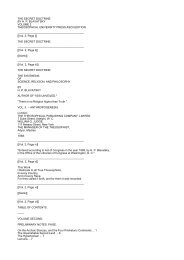Create successful ePaper yourself
Turn your PDF publications into a flip-book with our unique Google optimized e-Paper software.
The Gods Of The <strong>Book</strong> Of The <strong>Dead</strong>.<br />
millions <strong>of</strong> years to <strong>the</strong> deceased. When <strong>the</strong> great combat took place between Horus, <strong>the</strong> son <strong>of</strong> Isis, and<br />
Set, Thoth was present as judge, and he gave to Isis <strong>the</strong> cow's head in <strong>the</strong> place <strong>of</strong> her own which was cut<br />
<strong>of</strong>f by Horus in his rage at her interference; having reference to this fact he is called Ap-rehui, "The judge<br />
<strong>of</strong> <strong>the</strong> two combatants." One <strong>of</strong> <strong>the</strong> Egyptian names for <strong>the</strong> ibis was Tekh, and <strong>the</strong> similarity <strong>of</strong> <strong>the</strong> sound<br />
<strong>of</strong> this word to that <strong>of</strong> Tehu, <strong>the</strong> name <strong>of</strong> <strong>the</strong> moon as a measurer <strong>of</strong> time, probably led <strong>the</strong> Egyptians to<br />
depict <strong>the</strong> god in <strong>the</strong> form <strong>of</strong> an ibis, notwithstanding <strong>the</strong> fact that <strong>the</strong> dog-headed ape was generally<br />
considered to be <strong>the</strong> animal sacred to him. It has been thought that <strong>the</strong>re were two gods called Thoth, one<br />
being a form <strong>of</strong> Shu; but <strong>the</strong> attributes belonging to each have not yet been satisfactorily defined. In <strong>the</strong><br />
monuments and papyri Thoth appears in <strong>the</strong> form <strong>of</strong> a man with <strong>the</strong> head <strong>of</strong> an ibis, which is sometimes<br />
surmounted by <strong>the</strong> crown ###, or ###, or ###, or by disk and horns ###, or ###, and he holds in his left<br />
hand <strong>the</strong> sceptre ### and in <strong>the</strong> right {<strong>the</strong> ankh} ###; sometimes he is depicted holding his ink-jar and<br />
<strong>the</strong> crescent moon, and sometimes he appears in <strong>the</strong> form <strong>of</strong> an ape holding a palette full <strong>of</strong><br />
writing-reeds.' Thoth is mentioned in <strong>the</strong> pyramid texts[2] as <strong>the</strong> bro<strong>the</strong>r <strong>of</strong> Osiris, but whe<strong>the</strong>r he is <strong>the</strong><br />
[1. See Lanzone, op. cit., tav. 304, No. 1.<br />
2. Pyramid <strong>of</strong> Unas, l. 236.]<br />
{p. cxix}<br />
same Thoth who is called <strong>the</strong> "Lord <strong>of</strong> Khemennu" and <strong>the</strong> "Scribe <strong>of</strong> <strong>the</strong> gods" is doubtful.<br />
Maat, <strong>the</strong> wife <strong>of</strong> Thoth, was <strong>the</strong> daughter <strong>of</strong> Ra, and a very ancient goddess; she seems to have assisted<br />
Ptah and Khnemu in carrying out rightly <strong>the</strong> work <strong>of</strong> creation ordered by Thoth. There is no one word<br />
which will exactly describe <strong>the</strong> Egyptian conception <strong>of</strong> Maat both from a physical and from a moral<br />
point <strong>of</strong> view; but <strong>the</strong> fundamental idea <strong>of</strong> <strong>the</strong> word is " straight," and from <strong>the</strong> Egyptian texts it is clear<br />
that maat meant right, true, truth, real, genuine, upright, righteous, just, steadfast, unalterable, etc. Thus<br />
already in <strong>the</strong> Prisse papyrus it is said, "Great is maat, <strong>the</strong> mighty and unalterable, and it hath never been<br />
broken since <strong>the</strong> time <strong>of</strong> Osiris,"[1] and Ptah-hetep counsels his listener to "make maat, or right and<br />
truth, to germinate."[2] The just, upright, and straight man is maat and in a book <strong>of</strong> moral precepts it is<br />
said, "God will judge <strong>the</strong> right (maa)[3] ###[4]. Maat, <strong>the</strong> goddess <strong>of</strong> <strong>the</strong> unalterable laws <strong>of</strong> heaven, and<br />
<strong>the</strong> daughter <strong>of</strong> Ra, is depicted in female form, with <strong>the</strong> fea<strong>the</strong>r emblematic <strong>of</strong> maat, on her head, or with<br />
<strong>the</strong> fea<strong>the</strong>r alone for a head, and <strong>the</strong> sceptre in one hand, and {an ankh} in <strong>the</strong> o<strong>the</strong>r.[5] In <strong>the</strong> judgment<br />
scene two Maat goddesses appear; one probably is <strong>the</strong> personification <strong>of</strong> physical law, and <strong>the</strong> o<strong>the</strong>r <strong>of</strong><br />
moral rectitude.<br />
Het-heru, or Hathor <strong>the</strong> "house <strong>of</strong> Horus," was <strong>the</strong> goddess <strong>of</strong> <strong>the</strong> sky wherein Horus <strong>the</strong> sun-god rose<br />
and set. Subsequently a great number <strong>of</strong> goddesses <strong>of</strong> <strong>the</strong> same name were developed from her, and <strong>the</strong>se<br />
were identified with Isis, Neith, Iusaset, and many o<strong>the</strong>r goddesses whose attributes <strong>the</strong>y absorbed. A<br />
group <strong>of</strong> seven Hathors is also mentioned, and <strong>the</strong>se appear to have partaken <strong>of</strong> <strong>the</strong> nature <strong>of</strong> good fairies.<br />
In one form Hathor was <strong>the</strong> goddess <strong>of</strong> love, beauty,<br />
[1. Page 17, 1. 5, ###.<br />
2 Page 18, l. 1, ###.<br />
3. Amélineau, la Morale, p. 138.<br />
4. The various meanings <strong>of</strong> maat are illustrated by abundant passages from Egyptian texts by Brugsch, Wörterbuch<br />
(Suppl.), p. 329.<br />
http://www.sacred-texts.com/egy/ebod/ebod09.htm (9 <strong>of</strong> 19) [8/10/2001 11:23:59 AM]

















